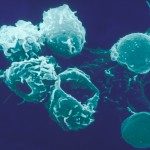Link to Pubmed [PMID] – 36630919
Link to DOI – 10.1016/j.immuni.2022.12.004S1074-7613(22)00640-9
Immunity 2023 Jan; 56(1): 78-92.e6
Tissue repair processes maintain proper organ function following mechanical or infection-related damage. In addition to antibacterial properties, mucosal associated invariant T (MAIT) cells express a tissue repair transcriptomic program and promote skin wound healing when expanded. Herein, we use a human-like mouse model of full-thickness skin excision to assess the underlying mechanisms of MAIT cell tissue repair function. Single-cell RNA sequencing analysis suggested that skin MAIT cells already express a repair program at steady state. Following skin excision, MAIT cells promoted keratinocyte proliferation, thereby accelerating healing. Using skin grafts, parabiosis, and adoptive transfer experiments, we show that MAIT cells migrated into the wound in a T cell receptor (TCR)-independent but CXCR6 chemokine receptor-dependent manner. Amphiregulin secreted by MAIT cells following excision promoted wound healing. Expression of the repair function was probably independent of sustained TCR stimulation. Overall, our study provides mechanistic insights into MAIT cell wound healing function in the skin.

